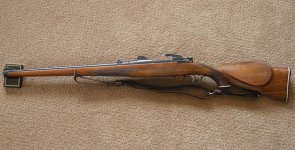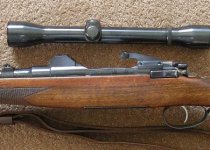At what point does a reconditioning become a refinishing? I just took delivery of a Mannlicher Shoenauer model 56. The metal is very good the stock is tired. Very few dents, the only cuts are in the top layer of the finish. Some of the finish is flakey and on the sharper edges like along the cheek piece it is rubbed down close to the wood. I was thinking of just hitting the wood lightly with some fine steel wool and rubbing it out with paste wax or furniture polish.
I'm interested in hearing opinions on when a reconditioning ends and a refinishing begins. And...where does my plan fall in terms of retaining value in the continuum between original and refinished.
A previous owner did a hack job on drilling and tapping scope mount holes on the top of the chamber and along the side of the receiver. The ones in front will be covered under the new front scope mounts but the blemished will still be there. The ones on the side of the receiver are neater and will look ok with plug screws. The metal is roll stamped under the mounting holes so any attempt to fill the holes will look worse than being plugged neatly with screws.
Bottom line, the gun is butchered enough that I wouldn’t be afraid of to strip the stock to the wood and start over. But if doing a touch up will get it looking good and preserve the guns value I will stop there. Having a nice looking gun that I can shoot is more important to me than collector value.
I'm interested in hearing opinions on when a reconditioning ends and a refinishing begins. And...where does my plan fall in terms of retaining value in the continuum between original and refinished.
A previous owner did a hack job on drilling and tapping scope mount holes on the top of the chamber and along the side of the receiver. The ones in front will be covered under the new front scope mounts but the blemished will still be there. The ones on the side of the receiver are neater and will look ok with plug screws. The metal is roll stamped under the mounting holes so any attempt to fill the holes will look worse than being plugged neatly with screws.
Bottom line, the gun is butchered enough that I wouldn’t be afraid of to strip the stock to the wood and start over. But if doing a touch up will get it looking good and preserve the guns value I will stop there. Having a nice looking gun that I can shoot is more important to me than collector value.




